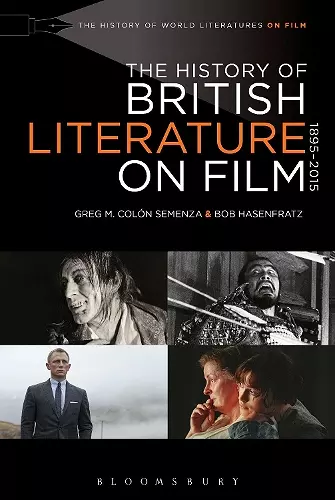The History of British Literature on Film, 1895-2015
Professor Greg M Colón Semenza author Bob Hasenfratz author
Format:Hardback
Publisher:Bloomsbury Publishing PLC
Published:16th Jul '15
Currently unavailable, and unfortunately no date known when it will be back

A comprehensive history of British literature on film, analyzing the changing cinematic art and politics of adaptation between the years 1896 and 2010.
From The Death of Nancy Sykes (1897) to The Hobbit: The Battle of the Five Armies (2014) and beyond, cinematic adaptations of British literature participate in a complex and fascinating history. The History of BritishLiteratureon Film, 1895-2015 is the only comprehensive narration of cinema's 100-year-old love affair with British literature. Unlike previous studies of literature and film, which tend to privilege particular authors such as Shakespeare and Jane Austen, or particular texts such as Frankenstein, or particular literary periods such as Medieval, this volume considers the multiple functions of filmed British literature as a cinematic subject in its own right—one reflecting the specific political and aesthetic priorities of different national and historical cinemas. In what ways has the British literary canon authorized and influenced the history and aesthetics of film, and in what ways has filmed British literature both affirmed and challenged the very idea of literary canonicity? Seeking to answer these and other key questions, this indispensable study shows how these adaptations emerged from and continue to shape the social, artistic, and commercial aspects of film history.
This rich analysis will appeal to Anglophile literature and film buffs alike. * Library Journal *
As adaptation studies proliferate and grow more rigorous into the twenty-first century, what has been lacking is the broad cultural and historical range that this fine book maps, providing a crucial perspective on the long evolution of adaptation in Britain. * Timothy Corrigan, Professor of English, Cinema Studies, and History of Art, University of Pennsylvania, USA, author of The Essay Film: From Montaigne, After Marker, and editor of Film and Literature: An Introduction and Reader *
Semenza and Hasenfratz (both, English, Univ. of Connecticut) present a comprehensive survey of the adaptation of British literature to film from the beginning of film in 1895 to the present. They look at the seeming inevitability of the marriage between British literature and movies and then consider the sustainability of the pairing over the decades. In doing this, the authors pave the way for using cinematic representations to get a better understanding of cultural history and identity. The authors also look at the impact of non-British filmmakers on these representations. In addition, the text explores four issues central to adaptation: fidelity to the original text; mutation, or how works grow and change through the adaptation process; genre, i.e., whether Brit-lit adaptations can be classified as a unique genre; and innovation, i.e., whether adapted works represent “progressive” or “conservative” modes of interpretation. Clearly and concisely written and including myriad illustrations and examples to help readers better contextualize and visualize the subject, this brilliant analysis of British literature on film is a valuable resource for both film and cultural studies. Summing Up: Essential. Lower-division undergraduates through faculty. * CHOICE *
The book’s mantra is ‘history matters’ and the authors’ approach throughout the volume is scrupulously historical, considering adaptations not by text or author, but in relation to other adaptations of a given period, progressing from the silent period to the current day. One thing they demonstrate, beyond a shadow of a doubt, is that in adaptation studies it is time to recognize that history matters. -- Deborah Cartmell Faculty of Humanities, De Montfort University, UK * Adaptation *
Semenza and Hasenfratz’s book certainly delights in its “capaciousness”: its 450+ dense pages consider everything from the rhetoric of early cinema advertisements in newspapers to anachronistic sound in Andrea Arnold’s Wuthering Heights (2011) ... Particularly welcome are the discussions of global Shakespeare, including an extensive analysis of Svend Gade and Heinz Schall’s German Hamlet (1920) and Akira Kurosawa’s Japanese Macbeth, Throne of Blood (Kumonosu-jô, 1957) ... The History of British Literature on Film is positioned to become a standard work in adaptation studies’ ongoing quest for self-definition, and could well function as a textbook for courses exploring Brit-Lit on the world stage. * Alphaville: Journal of Film and Screen Media *
Starting from the premise that 'history matters,' Greg M. Colón Semenza and Robert Hasenfratz embark on a survey of adaptations' changing sociocultural and political contexts across the twentieth century and since. Their core mission is to examine what the shifting industrial and commercial contexts of 'Brit-Lit' film adaptations reveal about wider trends in transatlantic relations, film-making practice and the discipline of adaptation studies itself. In fluent style they chart a vast swathe of film history and provide adaptation scholars with new ways of thinking about the long history of literature's lives on screen. * Simone Murray, Senior Lecturer in Literary Studies, Monash University, Australia, and author of The Adaptation Industry *
Rich, insightful and extraordinarily wide-ranging, this wonderful study of British Literature on film will be an invaluable resource. Superbly illustrated, eloquently written and truly global in scope, Semenza and Hasenfratz's book is a ground-breaking piece of work. * Mark Thornton Burnett, Professor of English, Queen’s University Belfast, UK *
ISBN: 9781623560430
Dimensions: unknown
Weight: 821g
488 pages